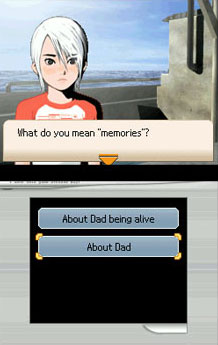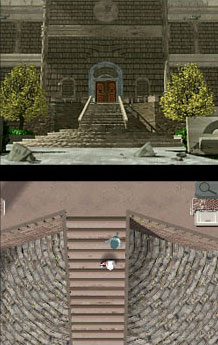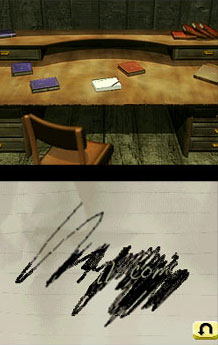"Life is very messy. The living leave traces of themselves wherever they go."1

Adventure games typically require item collecting, but not just the standard 'find key, insert key into door' collecting schtick action gamers are familiar with. No, adventure games often eschew the linear 'point A to point B' method of videogame problem solving in favor of a route that requires meandering from point A to points C-Z, such as 'find Mary's travel itinerary, note that she's out of town at the moment then find a sickly dog to distract the hotel security guard so you can sneak into her hotel room and pilfer the key.' This method of logic forces the player to interact more with their environment and the surrounding characters than they would in games of another genre. Characters in a successful adventure game have to be well-rounded; they require recognizable motives and personality in order for the world to feel fleshed out instead of just another shoot-em-up artifice. To propel this expositive action are a series of items which allow you to connect with the characters, to hear how they speak, see their mannerisms and form memories of your time together. Trace Memory takes this aging device and inverts, requiring characters to interact with items not to flesh out the world and characters around them, but to extrapolate on their own past, creating a poignant tale of estrangement and remembrance.
Ashley is a young girl on the verge of her 14th birthday when she receives a birthday package from her father, an uncommon event when you believe your father to be dead. Her guardian, Aunt Jennifer, explains that after her mother's mysterious death when Ashley was merely a toddler, her father insisted that she tell Ashley that he too had died, but reassured her that he'd come back for her some day. Upon opening her birthday package, Ashley finds a note requesting that she join him at his current residence on the remotely located Blood Edward Island and that she bring her gift with her: a small piece of hardware her father calls a 'Dual Trace System', or DTS. The handheld bears more than a passing resemblance to the gamer's Nintendo DS, and becomes integral to the story as well as a fundamental gameplay device.
Jennifer and Ashley sail over to the ominously named island only to have Jennifer disappear mere moments after landfall. Left to her own devices to now find Jennifer as well as her father, Ashley explores the island only to end up in a graveyard occupied by the tombs of the island's namesake, as well as a ghostly young boy who calls himself D. D's been waiting years for someone who can see his astral visage, someone whose 'heart and mind are pure' and that someone turns out to be Ashely. D pleads for her to help him discover his mortal fate, explaining that his memory of his mortal life has disappeared, and he longs to remember his life. Ashely sees in D a kindred spirit, someone who is just as unaware of their past and family as she is so they partner up, the two of them scouring the island for items to piece together their uncertain memories.
"People only forget what they want to forget."2
Trace Memory is uniquely concerned with memories: how they're constructed, how they're manipulated and how we remember them. Not only are Ashley and D focused on uncovering their pasts, but Ashley's father's scientific career has been mired in remembrance research. He and his wife had been researching methods of reshaping memories to aid trauma victims, those that couldn't bear to live with their current recollections. Ashley's gift, the Dual Trace System is part of that research, as well as a necessary part of Trace Memory's gameplay. The DTS allows Ashley to take photographs (to remember what she's seen), a card reader (to remember what others have written), a inventory manager (to remember what she's picked up) and the ability to save (to remember where she last was) and even more memory-related functions as time in the game progresses.

With her DTS in stow, Ashley and D stumble upon the mansion her father's been working in, the very same mansion that D's family grew up in. As they root around the spacious abode, they stumble over many objects of antiquity, objects that elucidate D's past, hinting at the kindred strife that occurred in the household long before Ashley's father arrived. Many of these objects also work towards bypassing obstructions in the house - locked doors, hidden passages, all of which bring Ashely closer to her father as well as stimulate memories of her mother's death. Of course, she (and by extension, you) have to finagle a bit with the items in make progress, and failing that, Ashley's DTS (and by extension, your DS) allows you to inventively succeed where a tchotchke otherwise fails, such as one puzzle the requires the closing and opening of your DS's lid to mimic a motion. While putting your DS to sleep may not be your first approach (or second, or sixth) to a problem, it's an unique (albeit frustrating) device. Nonetheless, the dual-screen nature of the DS allows split viewpoints: the bottom screen is reserved for a bird's-eye-view of Ashley & D's location in the mansion to aid you steer them via your stylus whereas the top screen is reserved for detailed shots of the surroundings, say a desk that may warrant closer examination. It's a serviceable set up that occasionally feels more natural than a standard mouse-based point-and-click interface as instead of clicking to instruct your characters to a point, you're constantly guiding them with your stylus: It feels not unlike they're holding onto your hand while you drag them throughout the house.
"Repetition helps me learn. Repetition helps me learn."3
Ashley has one more trick to aid her memory: repetition. At times she pauses to reflect and quiz herself on recent matters, reorienting herself to ensure that her memories aren't forgotten before she or D have their full stories. For the gamer on the other end it's a slightly tedious process but, from a thematic standpoint it certainly is clever. We as gamers are conditioned to remember gameplay techniques through simple repetition, so why not blend that with memory remembrance techniques? Somewhat unfortunately, the process feels like it's only for the benefit of the gamer: if you give the wrong answer to a question, Ashley will correct you and force you to keep guessing until you recall the right answer.
Regardless, details like the quiz showcase Trace Memory's relentless need to have both the narrative devices and gameplay techniques bound to the game's theme. While it's true that the DS-specific puzzles could be replaced with something more conventional and the plot would hardly suffer, the innovation here is in the concept. Trace Memory unequivocally capitalizes on videogame's ability to infuse the gamer with individual memories while they experience the world. When controlling a character in any game, your experiences (and consequently, memories) become shared. We do not feel as if we are on the outside looking in (as one might feel while watching a film), but we feel the events that occur in-game do so based on our actions. In Trace Memory we form our own memories as if Ashley's experiences are our own. As more time passes in game, more memories accumulate and work towards contaminating and confusing memories. The presence of Ashley's remembrance quizzes exist to purify and clarify these memories, as all parties involved struggle to unwind the narrative of the game and therefore, their lives.
These accumulated and manipulated memories, those formed during the game and those told through provoked flashbacks help flesh out all characters involved, especially Ashley and her father. As Ashley sorts out her experiences, we see her struggle with the dichotomy between what her intuition tells her, what her memories impart,and what the objects around her infer. Ashley reacts as any adolescent young girl might, with anger and lashing out, but she also has flashes of maturity and calm that, similar to her bone-white hair, lend us to believe she's seen more than a young girl should. She is a sturdily constructed character, one that feels honestly composed, and despite the strife and confusion she's encountering, she still has the vitality to delight in occasionally smashing something, or grow slightly distracted when getting lectured.

"I don't want to forget."4
The emotional depth and resonance of the characters pays off immensely in the closing chapters of the game, which see the plot stay intensely intimate instead of spiraling into absurdity, which given the nature of the DTS and Richard's work, it could easily do. Instead, Trace Memory remains a simple meditation about the nature of remembrance, both in its narrative as well as in its gameplay. It's an extraordinarily focused game, it knows what it wants to achieve and it doesn't try and pad itself with inane unpleasantries such as intense backtracking, as are typical fare for an adventure game. This also means that it is a relatively brief experience, one that serves up five or six hours of gameplay from beginning to end. However, as there are two mysteries going on in tandem playing it twice seems almost necessary, especially as it's not difficult to accidentally overlook significant clues concerning D's past. Yes, it's possible to reach the end of the game without solving D's mysteries, serving to leave the player slightly melancholic when all of Ashley's memories have been pieced together but he's left with a incomplete picture of his mortal life, left to wander the island until someone else with a pure heart and mind aids him in his search.
By the time you reached this point in the game, your inventory is absolutely bulging: nine pages of itemization containing everything from candies to a simple shoe. Depending how you played the game, you may have found the reason for each item you picked up. You may know the why it holds meaning to D, or its place in the mansion, or you may never know. Certainly there was a place for that object though, a reason for its existence that enlightens some matter, if ever so slightly. Trace Memory subverts the standard adventure genre by working backwards, imparting meaning to the items, loading them with context and waiting for the player to stumble over them, as opposed to the other way around. Thanks to this ingenuity, we're treated to a theme that extends beyond just the narrative to bring the entire game to a cohesive whole. And while Trace Memory may be a bit too smart with some of their befuddling puzzles, at least there's a purpose for them, an extended reason behind their existence that reaches beyond 'just another locked door'. These concept pieces in games are few and far between and it's even rarer when the concept is pulled off, which is exactly what makes Trace Memory such a distinguished experience.
1 - Trace Memory. Nintendo/Jinx, 2005.
2 - Trace Memory. . Nintendo/Jinx, 2005.
3 - Peter Greenaway, Lecture at the Art Institute of Chicago Film Center, 1997.
4 - Trace Memory. . Nintendo/Jinx, 2005.




#1 hobbie Mar 16, 2006 01:25pm
I grabbed a copy for $20 at my local Sear's. Once I find my stylus, I'll give this a whirl.
#2 D. Riley Mar 16, 2006 02:00pm
Thanks for bumping this hobbie, now there's MORE MONEY I NEED TO SPEND WHEN I GET A DS.
Hooray!